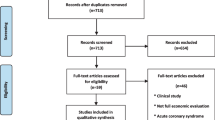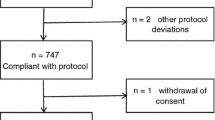Abstract
To summarize the results of all original cost-utility analyses (CUAs) in diagnostic cardiovascular imaging (CVI) and characterize those technologies by estimates of their cost-effectiveness. We systematically searched the literature for original CVI CUAs published between 2000 and 2008. Studies were classified according to several variables including anatomy of interest (e.g. cerebrovascular, aorta, peripheral) and imaging modality under study (e.g. angiography, ultrasound). The results of each study, expressed as cost of the intervention to number of quality-adjusted life years saved ratio (cost/QALY) were additionally classified as favorable or not using $20,000, $50,000, and $100,000 per QALY thresholds. The distribution of results was assessed with Chi Square or Fisher exact test, as indicated. Sixty-nine percent of all cardiovascular imaging CUAs were published between 2000 and 2008. Thirty-two studies reporting 82 cost/QALY ratios were included in the final sample. The most common vascular areas studied were cerebrovascular (n = 9) and cardiac (n = 8). Sixty-six percent (21/32) of studies focused on sonography, followed by conventional angiography and CT (25%, n = 8, each). Twenty-nine (35.4%), 42 (51.2%), and 53 (64.6%) ratios were favorable at WTP $20,000/QALY, $50,000/QALY, and $100,000/QALY, respectively. Thirty (36.6%) ratios compared one imaging test versus medical or surgical interventions; 26 (31.7%) ratios compared imaging to a different imaging test and another 26 (31.7%) to no intervention. Imaging interventions were more likely (P < 0.01) to be favorable when compared to observation, medical treatment or non-intervention than when compared to a different imaging test at WTP $100,000/QALY. The diagnostic cardiovascular imaging literature has growth substantially. The studies available have, in general, favorable cost-effectiveness profiles with major determinants relating to being compared against observation, medical or no intervention instead of other imaging tests.


Similar content being viewed by others
References
Lloyd-Jones D, Adams R, Carnethon M et al (2009) Heart disease and stroke statistics-2009 update: a report from the American Heart Association Statistics Committee and Stroke Statistics Subcommittee. Circulation 119(3):480–486
Iglehart JK (2006) The new era of medical imaging–progress and pitfalls. N Engl J Med 354:2822–2828
Levin DC, Rao VM, Parker L, Frangos AJ, Sunshine JH (2005) Recent trends in utilization of cardiovascular imaging: how important are they for radiology? J Am Coll Radiol 2:736–739
Picano E (2005) Economic and biological costs of cardiac imaging. Cardiovasc Ultrasound 3:13
Kielar AZ, El-Maraghi RH, Carlos RC (2007) Health-related quality of life and cost-effectiveness analysis in radiology. Acad Radiol 14:411–419
Singer ME, Applegate KE (2001) Cost-effectiveness analysis in radiology. Radiology 219:611–620
Weinstein MC, Siegel JE, Gold MR, Kamlet MS, Russell LB (1996) Recommendations of the panel on cost-effectiveness in health and medicine. JAMA 276:1253–1258
Neumann PJ, Rosen AB, Weinstein MC (2005) Medicare and cost-effectiveness analysis. N Engl J Med 353:1516–1522
Cost-Effectiveness Analysis Registry (2006) In: Boston: Tufts Medical Center, Institute for Clinical Research & Health Policy Studies 2006. http://www.cearegistry.org
Organization WH (1992) International Classification of Diseases and related health problems In: Geneva: WHO 1992. www.who.int/classifications/icd/en/
Laupacis A, Feeny D, Detsky AS, Tugwell PX (1992) How attractive does a new technology have to be to warrant adoption and utilization? Tentative guidelines for using clinical and economic evaluations. Cmaj 146:473–481
Kim HM, Kuntz KM, Cronan JJ (2000) Optimal management strategy for use of compression US for deep venous thrombosis in symptomatic patients: a cost-effectiveness analysis. Acad Radiol 7(2):67–76
Derdeyn CP, Gage BF, Grubb RL Jr, Powers WJ (2000) Cost-effectiveness analysis of therapy for symptomatic carotid occlusion: PET screening before selective extracranial-to-intracranial bypass versus medical treatment. J Nucl Med 41(5):800–807
Bluth EI, Sunshine JH, Lyons JB, Beam CA, Troxclair LA, Althans-Kopecky L et al (2000) Power Doppler imaging: initial evaluation as a screening examination for carotid artery stenosis. Radiology 215(3):791–800
Perone N, Bounameaux H, Perrier A (2001) Comparison of four strategies for diagnosing deep vein thrombosis: a cost-effectiveness analysis. Am J Med 110(1):33–40
Keen JD, Keen RR (2001) The cost-effectiveness of exclusion arteriography in extremity trauma. Cardiovasc Surg 9(5):441–447
Multicentre Aneurysm Screening Study Group (2002) Multicentre aneurysm screening study (MASS): cost effectiveness analysis of screening for abdominal aortic aneurysms based on four year results from randomised controlled trial. BMJ 325(7373):1135
Connelly JB, Hill GB, Millar WJ (2002) The detection and management of abdominal aortic aneurysm: a cost-effectiveness analysis. Clin Invest Med 25(4):127–133
Lee TY, Korn P, Heller JA, Kilaru S, Beavers FP, Bush HL, Kent KC (2002) The cost-effectiveness of a “quick-screen” program for abdominal aortic aneurysms. Surgery 132(2):399–407
Carlos RC, Axelrod DA, Ellis JH, Abrahamse PH, Fendrick AM (2003) Incorporating patient-centered outcomes in the analysis of cost-effectiveness: imaging strategies for renovascular hypertension. AJR Am J Roentgenol 181(6):1653–1661
Cox CE, Carson SS, Biddle AK (2003) Cost-effectiveness of ultrasound in preventing femoral venous catheter-associated pulmonary embolism. Am J Respir Crit Care Med 168(12):1481–1487
Fearon WF, Yeung AC, Lee DP, Yock PG, Heidenreich PA (2003) Cost-effectiveness of measuring fractional flow reserve to guide coronary interventions. Am Heart J 145(5):882–887
Visser K, de Vries SO, Kitslaar PJ, van Engelshoven JM, Hunink MG (2003) Cost-effectiveness of diagnostic imaging work-up and treatment for patients with intermittent claudication in The Netherlands. Eur J Vasc Endovasc Surg 25(3):213–223
Visser K, Kuntz KM, Donaldson MC, Gazelle GS, Hunink MG (2003) Pretreatment imaging workup for patients with intermittent claudication: a cost-effectiveness analysis. J Vasc Interv Radiol 14(1):53–62
Hayashino Y, Nagata-Kobayashi S, Morimoto T, Maeda K, Shimbo T, Fukui T (2004) Cost-effectiveness of screening for coronary artery disease in asymptomatic patients with Type 2 diabetes and additional atherogenic risk factors. J Gen Intern Med 19(12):1181–1191
Wardlaw JM, Seymour J, Cairns J, Keir S, Lewis S, Sandercock P (2004) Immediate computed tomography scanning of acute stroke is cost-effective and improves quality of life. Stroke 35(11):2477–8322
Buskens E, Nederkoorn PJ, Buijs-Van Der Woude T, Mali WP, Kappelle LJ, Eikelboom BC et al (2004) Imaging of carotid arteries in symptomatic patients: cost-effectiveness of diagnostic strategies. Radiology 233(1):101–112
Post PN, Kievit J, van Bockel JH (2004) Optimal follow-up strategies after aorto-iliac prosthetic reconstruction: a decision analysis and cost-effectiveness analysis. Eur J Vasc Endovasc Surg 28(3):287–295
O’Malley PG, Greenberg BA, Taylor AJ (2004) Cost-effectiveness of using electron beam computed tomography to identify patients at risk for clinical coronary artery disease. Am Heart J 148(1):106–113
Wilson RD, Murray PK (2005) Cost-effectiveness of screening for deep vein thrombosis by ultrasound at admission to stroke rehabilitation. Arch Phys Med Rehabil 86:1941–1948
UK-I JM, Hollingworth W, Trivedi RA et al (2005) Cost-effectiveness of diagnostic strategies prior to carotid endarterectomy. Ann Neurol 58:506–515
Taylor AJ, Bindeman J, Feuerstein I, Cao F, Brazaitis M, O’Malley PG (2005) Coronary calcium independently predicts incident premature coronary heart disease over measured cardiovascular risk factors: mean three-year outcomes in the Prospective Army Coronary Calcium (PACC) project. J Am Coll Cardiol 46(5):807–1429
Wanhainen A, Lundkvist J, Bergqvist D, Björck M (2005) Cost-effectiveness of different screening strategies for abdominal aortic aneurysm. J Vasc Surg 41(5):741–751
Henriksson M, Lundgren F, Carlsson P (2006) Informing the efficient use of health care and health care research resources—the case of screening for abdominal aortic aneurysm in Sweden. Health Econ 15(12):1311–1322
Hayashino Y, Shimbo T, Tsujii S, Ishii H, Kondo H, Nakamura T, Nagata-Kobayashi S, Fukui T (2007) Cost-effectiveness of coronary artery disease screening in asymptomatic patients with type 2 diabetes and other atherogenic risk factors in Japan: factors influencing on international application of evidence-based guidelines. Int J Cardiol 118(1):88–9634
Meenan RT, Saha S, Chou R, Swarztrauber K, Pyle Krages K, O’Keeffe-Rosetti MC, McDonagh M, Chan BK, Hornbrook MC, Helfand M (2007) Cost-effectiveness of echocardiography to identify intracardiac thrombus among patients with first stroke or transient ischemic attack. Med Decis Making 27(2):161–177
Liao L, Kong DF, Samad Z, Pappas PA, Jollis JG, Lin SS, Wang A, Fowler VG Jr, Chu VH, Sexton DJ, Corey GR, Cabell CH (2008) Echocardiographic risk stratification for early surgery with endocarditis: a cost-effectiveness analysis. Heart 94(5):e18
Wermer MJ, Koffijberg H, van der Schaaf IC, ASTRA Study Group (2008) Effectiveness and costs of screening for aneurysms every 5 years after subarachnoid hemorrhage. Neurology 70(22):2053–6238
Takao H, Nojo T, Ohtomo K (2008) Screening for familial intracranial aneurysms: decision and cost-effectiveness analysis. Acad Radiol 15(4):462–471
Brown DL, Hoffman SN, Jacobs TL, Gruis KL, Johnson SL, Chernew ME (2008) CT angiography is cost-effective for confirmation of internal carotid artery occlusions. J Neuroimaging 18(4):355–359
Montreuil B, Brophy J (2008) Screening for abdominal aortic aneurysms in men: a Canadian perspective using Monte Carlo-based estimates. Can J Surg 51(1):23–34
Khare RK, Courtney DM, Powell ES, Venkatesh AK, Lee TA (2008) Sixty-four-slice computed tomography of the coronary arteries: cost-effectiveness analysis of patients presenting to the emergency department with low-risk chest pain. Acad Emerg Med 15(7):623–632
Ladapo JA, Hoffmann U, Bamberg F, Nagurney JT, Cutler DM, Weinstein MC, Gazelle GS (2008) Cost-effectiveness of coronary MDCT in the triage of patients with acute chest pain. AJR Am J Roentgenol 191(2):455–463
Mongan JJ, Ferris TG, Lee TH (2008) Options for slowing the growth of health care costs. N Engl J Med 358:1509–1514
Bell CM, Urbach DR, Ray JG et al (2006) Bias in published cost effectiveness studies: systematic review. BMJ 332:699–703
Otero HJ, Rybicki FJ, Greenberg D, Neumann PJ (2008) Twenty years of cost-effectiveness analysis in medical imaging: are we improving? Radiology 249(3):917–925
Perry JT, Statler JD (2007) Advances in vascular imaging. Surg Clin North Am 87(5):975–993
Rowe VL, Tucker SW (2004) Advances in vascular imaging. Surg Clin North Am 84(5):1189–1202
Boyajian RA, Otis SM (2002) Integration and added value of the modern noninvasive vascular laboratory in vascular diseases management. J Neuroimaging 12(2):148–152
Fillinger MF (1997) Cost-effective use of the noninvasive vascular laboratory: potential trends related to increased economic pressures. Semin Vasc Surg 10(2):98–105
Zwiebel WJ (1995) The clinical and financial impact of non-invasive vascular testing in the USA. Australas Radiol 39(3):309–313
American College of Radiology. ACR Appropriateness Criteria®. Available at: http://www.acr.org/SecondaryMainMenuCategories/quality_safety/app_criteria.aspx. Accessed 27 Dec 2009
Patel MR, Spertus JA, Brindis RG, Hendel RC, Douglas PS, Peterson ED et al (2005) ACCF proposed method for evaluating the appropriateness of cardiovascular imaging. J Am Coll Cardiol 46(8):1606–1613
Brenner DJ, Hall EJ (2007) Computed tomography: an increasing source of radiation exposure. N Engl J Med 357(22):2277–2284
Rybicki FJ (2009) Lower radiation dose coronary CT angiography with new imaging technologies. Int J Cardiovasc Imaging 25:149–151
National Council on Radiation Protection and Measurements (2009) Ionizing radiation exposure of the population of the United States: recommendations of the National Council on Radiation Protection and Measurements. Report no. 160. Bethesda, MD: NCRP, March 2009
Su KM, MacKenzie JD, Smith JB, Blinder EM, Bourgeois LM, Ledbetter S, Castrronovo FP, Judy PF, Rybicki FJ (2006) Lowering the thyroid dose in screening examinations of the cervical spine. Emerg Radiol 12(3):133–136
Einstein AJ, Henzlova MJ, Rajagopalan S (2007) Estimating risk of cancer associated with radiation exposure from 64-slice computed tomography coronary angiography. JAMA 298(3):317–323
Acknowledgments
The work was done with partial support from NIH grant number K23-EB882-05 (PI: Rybicki).
Author information
Authors and Affiliations
Corresponding author
Rights and permissions
About this article
Cite this article
Otero, H.J., Rybicki, F.J., Greenberg, D. et al. Cost-effective diagnostic cardiovascular imaging: when does it provide good value for the money?. Int J Cardiovasc Imaging 26, 605–612 (2010). https://doi.org/10.1007/s10554-010-9634-z
Received:
Accepted:
Published:
Issue Date:
DOI: https://doi.org/10.1007/s10554-010-9634-z




